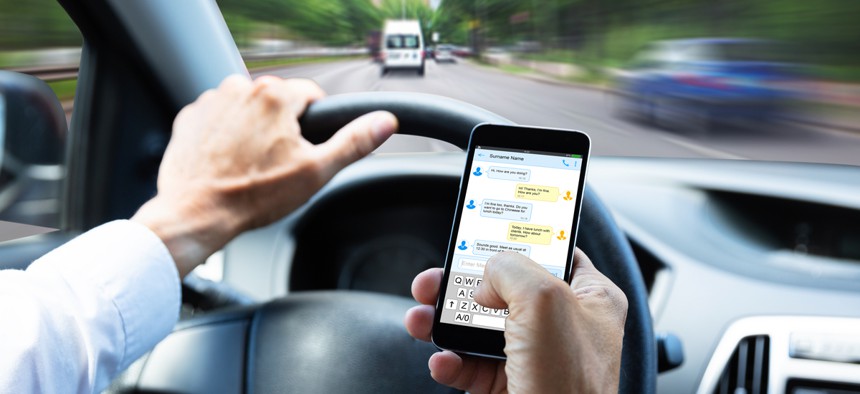'Phone Addicts' Are the New Drunk Drivers, Report Says

Music and phone apps are most commonly used while driving, edging out texting and social media, the report found. Shutterstock
An analysis of driver behavior data found that drivers are growing more distracted by their devices.
Drivers are 10 percent more distracted now than last year, a problem driven largely by smartphones, according to new research from Zendrive, a company that collects and analyzes data on driver behaviors.
“Out from under the shadows, phone addicts have positioned themselves as public enemy number one, replacing drunk drivers as the ultimate threat on the road," says the 2019 distracted driving study, released this week.
The study analyzed driving data from 1.8 million anonymized drivers over 92 days, for a total of 4.5 billion miles. All data comes from smartphone sensors, which detect phone usage “when the driver handles the phone for a certain period of time for various purposes such as talking, texting, or navigating.” Researchers also spoke to 500 drivers to obtain details on how they use phones while driving, including which apps were most commonly tapped by people behind the wheel.
The results found that “phone addicts”—broadly defined as people who are unable or unwilling to put away their phones while driving—pick up their phones four times more than the average driver, use their phone six times longer and have their eyes off the road 28 percent of the time. And their numbers are increasing—the number of “hardcore phone addicts” identified by the company doubled from last year.
“Today, one in 12 drivers on the road is a phone addict,” the report says. “If these trends continue, as many as one in every five drivers could be in the phone addict category by 2022.”
Drivers distracted by their phones may already be more dangerous than drunk drivers. In 2016, the National Highway Traffic Safety Administration reported 10,497 deaths as a result of drunk driving, and 3,450 deaths from distracted drivers. But fatalities caused by driver phone use are more difficult to track and likely underreported, according to the report.
“Drivers failing to admit they were distracted prior to a crash and inconsistencies in police reports make it difficult to arrive at an accurate number,” it says. “But there are other reasons to believe mobile phones are deadlier than NHTSA suggests.”
For example, roughly 660,000 drivers use their cell phones while driving, according to NHTSA data. Last year, Zendrive data showed “that the problem was 100 times worse than reported by the government’s dataset. Over 69 million people use their phones at least once in awhile behind the wheel.”
And those people are driving day and night, the report notes, while drunk drivers are most active between midnight and 3 a.m. That means “that both in number and in timing, distracted drivers are a bigger danger than drunk drivers.”
Distracted driving increased in each state, but Virginia was the “most distracted” on the list. Residents there spend an average of 9.45 percent of their time behind the wheel on their phones. Montana (9.14 percent), New Hampshire (9), Georgia (8.69) and Mississippi (8.63) round out the top five. By contrast, the least distracted states are Pennsylvania (6.47 percent), New York (6.74), Oregon (6.83), South Carolina (6.89) and South Dakota (7.03).
The most commonly used apps while driving are music and phone apps, edging out social media and texting. State laws and municipal regulations that ban the use of handheld devices entirely while driving could help the problem, the report concludes.
“While 47 states (including the District of Columbia) ban text messaging, talking on a handheld phone while driving is only banned in 16 states nationwide,” it says. “Although texting laws are a huge step forward, immediate and aggressive action needs to be taken against handheld phone use. We believe enforcing handheld bans can make a positive impact on states across the board next year.”
Kate Elizabeth Queram is a Staff Correspondent for Route Fifty and is based in Washington, D.C.
NEXT STORY: U.S. Education Dept. Sued Over Blocking Access to Advocacy Group’s Website From Within Office Building





